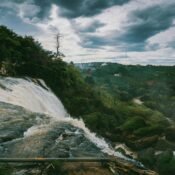
Hidden Waterfalls & Hills: Off‑the‑Beaten‑Path in Tanzania
When most travelers think of Tanzania, iconic destinations like Serengeti National Park, Mount Kilimanjaro, or the turquoise beaches of Zanzibar come to mind. But beyond the famed safari trails and postcard-perfect shores lies another side of Tanzania—one teeming with secluded waterfalls, verdant hills, and mystical landscapes rarely touched by mass tourism.
For those with a spirit of adventure and a love for raw, unspoiled nature, Tanzania’s hidden waterfalls and hilly terrains offer a different kind of magic—quiet, spiritual, and breathtakingly beautiful. In this blog, we take you on a journey through some of these hidden gems tucked away from the tourist radar.
1. Sanje Waterfalls – Udzungwa Mountains
Tucked deep within the lush Udzungwa Mountains National Park, Sanje Waterfalls are nothing short of spectacular. Towering at around 170 meters, these falls are among the highest in Tanzania. The hike to the waterfall is as enchanting as the destination itself, weaving through tropical forests filled with endemic species like the Iringa red colobus monkey and rare birds.
The view from the top, overlooking the Kilombero Valley, is a moment of pure awe. If you’re up for a swim, the natural pool at the base of the falls offers a refreshing plunge. This destination is perfect for eco-travelers and hiking enthusiasts who enjoy combining adventure with nature conservation.
2. Matema Hills & Waterfalls – Lake Nyasa (Lake Malawi)
The village of Matema, resting along the northern shores of Lake Nyasa, is surrounded by dramatic hills and secret waterfalls. This area is a dream come true for travelers seeking tranquility and authentic rural life.
The surrounding hills offer scenic hiking trails that reveal untouched cascades flowing through dense forests. These trails are usually guided by local villagers who are more than happy to share stories about the land and its customs. After a hike, you can relax by the lake’s black-sand beaches or take a canoe trip to nearby fishing communities.
3. Mambo Viewpoint & Usambara Hills
The Usambara Mountains are one of Tanzania’s best-kept secrets. Unlike the bustling safari circuits, the Usambaras are cool, green, and heavily forested. The Mambo Viewpoint Eco Lodge, perched near the village of Mambo in the West Usambaras, offers panoramic views of the Pare Mountains, Mkomazi plains, and even Mount Kilimanjaro on a clear day.
Short treks from the viewpoint lead you to hidden waterfalls and colonial-era villages nestled within tea and eucalyptus plantations. The surrounding area is a haven for birdwatchers, botanists, and photographers. It’s also an ideal destination for cultural interaction with local communities who live in harmony with the hills.
4. Olmoti & Empakaai Craters – Ngorongoro Highlands
While most visitors rush straight to the famed Ngorongoro Crater, the highlands around it hide some of Tanzania’s most dramatic and lesser-known landscapes. Two such spots are the Olmoti and Empakaai Craters.
Olmoti Crater features a gentle trail through montane forests and open grasslands, ending at a serene waterfall within the crater itself. A short drive away, the Empakaai Crater offers a steeper but equally rewarding descent into a pristine caldera filled with a soda lake that attracts flamingos.
These hikes are guided by local Maasai warriors, adding cultural depth to the experience as they share traditional lore and their bond with the land.
5. Kikuletwa (Chemka) Hot Springs – Near Moshi
Though not exactly a waterfall or a hill, the Kikuletwa Hot Springs, also known as Chemka, deserves a mention for its surreal beauty. Hidden amidst baobab trees and banana plantations, this turquoise oasis is fed by underground geothermal springs, forming a warm, clear-water pool perfect for swimming and relaxing.
The journey to reach Chemka takes you through dusty village roads and scenic countryside—a prelude to the hidden paradise that awaits. It’s an excellent day trip from Moshi or Arusha, especially for travelers en route to Kilimanjaro who want a quiet, nature-filled stopover.
6. Mbeya and the Southern Highlands
The Southern Highlands around Mbeya offer another layer of Tanzania’s geographic diversity. Nestled among rolling hills and fertile valleys, Mbeya is a hub for agro-tourism, coffee tours, and scenic drives.
A hidden gem in this region is the Kaporogwe Waterfall, cascading from a limestone cliff into a lush forest ravine. The waterfall is not only a natural wonder but also holds cultural significance to local tribes. A visit here can be paired with treks to nearby volcanic peaks like Mount Rungwe and Ngozi Crater Lake, one of the largest crater lakes in Africa.
7. Magamba Forest – Lushoto
Just above the town of Lushoto, the Magamba Forest Reserve offers cool air, rich biodiversity, and a web of trails leading to small but beautiful waterfalls. The forest is home to black-and-white colobus monkeys, chameleons, and countless bird species.
One popular trek is from Lushoto town to Irente Viewpoint, passing through Magamba Forest and offering several scenic rest spots by trickling waterfalls and hidden springs. The trail is ideal for slow travelers who prefer immersive nature walks over adrenaline-packed adventures.
Final Thoughts
Tanzania’s natural beauty runs far deeper than its iconic safari destinations. Its hills whisper ancient stories, and its waterfalls tumble down in places untouched by tour buses. Exploring these off-the-beaten-path spots offers not just stunning views, but also moments of serenity, cultural discovery, and a deeper connection to the soul of the land.
So next time you think of Tanzania, go beyond the usual. Follow the trails less taken, chase the hidden waterfalls, and let the hills reveal a side of Tanzania that few have the privilege to see.




